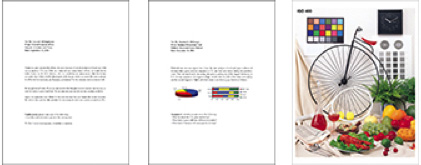Methodology
Maximum pages/copies per minute (PPM/CPM) are measured after first page with text patterns in Draft Mode (or Economy Mode, depending on the printer/all-in-one) on plain paper. Actual print/copy times will vary based on system configuration, software, and page complexity.
Testing is conducted with the patterns depicted below in Microsoft® Word. The printer/all-in-one uses plain, 8.5" x 11" paper. Tests are performed at least three times using at least three sample products. Tests do not measure processing time, which varies, depending on the computer configuration, image, software, and connectivity. Timing begins when the second page starts to feed into the product and continues for 60 seconds. Results are rounded down, but not rounded up.
Color Photo Print Speeds
Color photo printed without borders in Draft Mode on Premium Photo Paper Glossy measured from start of paper feed. Actual print times will vary based on system configuration, software, and page complexity.
Testing is conducted with the image depicted below using Adobe® Photoshop® software on photo paper in draft mode, unless otherwise specified. Tests are performed at least three times using at least three sample products. Tests do not measure processing time, which varies, depending on the computer configuration, image, software, and connectivity. Timing begins from commencement of paper feed until the photo ejects. Results are rounded down, but not rounded up.
Test Patterns Used

Testing Conditions and Equipment Used
Tests are run in a climate-controlled office environment (72 ºF, about 40% relative humidity), using current, readily available equipment. As of May 2008, Epson began using Dell® Dimension series desktop computers with Intel® Core 2 Duo 1.86 GHz or Athlon 64 X2 Dual Core 2.20 GHz processors with 2.0GB of RAM running Microsoft Windows XP, Service Pack 3. Imaging devices are connected via USB 2.0 cables. Time is recorded by a lab technician with an electronic stopwatch.